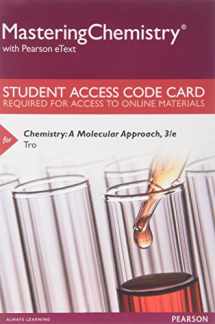
MasteringChemistry with Pearson eText -- Standalone Access Card -- for Chemistry: A Molecular Approach, Student Solutions Manual for Chemistry (3rd Edition)
Book details
Summary
Description
ALERT: Before you purchase, check with your instructor or review your course syllabus to ensure that you select the correct ISBN. Several versions of Pearson's MyLab & Mastering products exist for each title, including customized versions for individual schools, and registrations are not transferable. In addition, you may need a CourseID, provided by your instructor, to register for and use Pearson's MyLab & Mastering products.
This includes all of the resources of MasteringChemistry in addition to Pearson eText content.
The Mastering platform is the most effective and widely used online homework, tutorial, and assessment system for the sciences. It delivers self-paced tutorials that focus on your course objectives, provide individualized coaching, and respond to each student’s progress. The Mastering system helps instructors maximize class time with easy-to-assign, customizable, and automatically graded assessments that motivate students to learn outside of class and arrive prepared for lecture or lab.
New to MasteringChemistry:
- MasteringChemistry metadata analysis of problems/tutorials assigned in the previous edition have been used to revise end-of-chapter problems in the Third Edition.
- Approximately 1,000 end-of-chapter questions have been enhanced with feedback, meeting instructor’s need for more tutorial-like questions.
- Interactive versions of selected worked examples in the text have been created and are incorporated into MasteringChemistry as assignable tutorial activities, providing an office hour-like experience. These can also be used for mobile learning through a downloadable app.
- 15 Pause and Predict Video Quizzes bring chemistry to life with lab demonstrations illustrating key topics in general chemistry. Students are asked to predict the outcome of experiments as they watch the videos; a set of multiple-choice questions challenges students to apply the concepts from the video to related scenarios.
- 8 PhET tutorials have been developed around interactive applets that foster conceptual understanding and active learning. Topics include acid-base solutions, balancing chemical equations, and molecular polarity.
- Multiple-choice Reading Questions are provided for each chapter, making it easy to hold students accountable for doing assigned readings before lecture.
- Enhanced end-of-chapter questions within MasteringChemistry providing wrong-answer feedback have been added.
- Sketch-it type problems have been added for each chapter.
- Simulations cover some of the most difficult chemistry concepts and are written by the leading authors in simulation development.
- Select end-of-chapter questions and reading quizzes have been tagged to learning outcomes.
- The overall number of algorithmic and randomized problems have been increased to 40%, offering a more rounded program for departments moving to online high-stakes testing.


We would LOVE it if you could help us and other readers by reviewing the book
Book review



